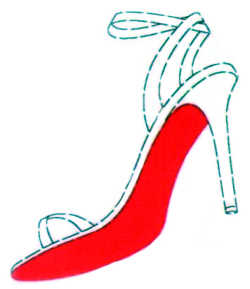Position marks: Christian Louboutin v Van Haren Schoenen
This Advocate General (AG) opinion suggests that obtaining/retaining protection for non-traditional signs (in particular position marks) may become increasingly difficult.
Background
Christian Louboutin (Louboutin) obtained a Benelux trade mark registration in class 25 for “footwear (other than orthopaedic footwear)” in 2010. The registration was limited in 2013 to “high heeled shoes (other than orthopaedic shoes)”. The registration included the following description: “the colour red (Pantone 18 1663TP) applied to the sole of a shoe as shown (the contour of the shoe is not part of the trade mark but is intended to show the positioning of the mark)”. The mark is shown below:

Latest update on this case
Louboutin SAS v Van Haren Schoenen: Additional opinion of Advocate General Szpunar
Read latest update on this caseLouboutin sued the Dutch retailer Van Haren for selling high-heeled women’s shoes with red soles. The initial decision went in Louboutin’s favour but Van Haren challenged the validity of Louboutin’s registration, arguing that it is a two-dimensional mark (the colour red) which conforms to the shape of the shoes and gives substantial value (an objection under Article 3(1)(e)(iii) of Directive 2008/95/EC).
The Dutch Court (Rechtbank Den Haag) stayed proceedings and asked the Court of Justice of the European Union (CJEU) to clarify whether “shape” under Article 3(1)(e)(iii) is limited to 3-dimensional properties, like contours, measurements and volume, thus excluding colours.
AG’s opinion
The AG’s view was that classification as a figurative mark does not prevent it from being considered “a mark consisting of the shape of the goods”. The question is whether the mark seeks to protect colour per se, or colour in conjunction with other characteristics relating to shape. Protection was not being sought for a colour in the abstract, but in the context of a high-heeled shoe. The colour relates to a well-defined part of the goods (the sole of a shoe), and the AG found it possible for the colour to be considered “indissociable from a specific element of the goods”.
Louboutin’s registration did not seek protection for the contours of the shoe, but that was not decisive. Consideration should be given to whether the sign garners its distinctive character from the colour per se, or the exact positioning of that colour in relation to other elements of the goods. The AG leaned towards the latter, finding that the mark is best conceptualised as consisting of the shape of the goods which seeks protection for colour in relation to that shape.
In assessing whether Art 3(1)(e) should apply, the AG looked at the aim of the provision, which is to prevent monopolisation of functional/technical characteristics. He stated “colour can be an essential practical characteristic of certain goods, such that monopolisation of colour, in relation to an element of the shape of the goods, would remove freedom from competitors to offer goods incorporating the same functionality”. He considered the provision to potentially apply to signs consisting of the shape of the goods which also seek protection for a certain colour.
Whilst the request for a preliminary ruling did not specifically seek clarification of Art 3(1)(e)(iii), namely shapes which give substantial value, the AG noted that the provision could ensnare shape marks which had other essential functions, besides aesthetic appeal.
If Louboutin’s registration were to be considered a colour mark, it would not fall foul of Art 3(1)(e). However, as the AG acknowledged, colour marks are not typically considered inherently distinctive. Whilst colour marks can acquire distinctiveness through use, there is a balance to be struck by not unduly restricting the availability of colours for third parties. Similar policy considerations apply to shape marks – there is an underlying interest in keeping technical/functional shapes in the public domain. However, signs falling foul of shape objections cannot be ‘saved’ by acquired distinctiveness. If the CJEU follows the AG’s opinion, it may spell the end for Louboutin’s Benelux registration.
In short
The AG’s opinion allows for Louboutin’s mark to be categorised as a sign consisting of the shape of the goods, seeking protection for a colour in relation to that shape. Further, if the red colour is considered to be a functional element then Louboutin’s registration may be deemed invalid.
The opinion indicates that “shape” under the current Directive 2008/95 can be interpreted broadly and include non-three-dimensional characteristics. However, the new EUTM Directive 2015/2436 refers to “signs which consist exclusively of the shape, or another characteristic”, which may lead to more intuitive objections against two-dimensional features, like colour as applied to goods.
Ultimately, the opinion suggests that shape objections are more readily applicable to non-traditional trade marks such as position marks.
Case details at a glance
Jurisdiction: European Union
Decision level: Advocate General
Parties: Christian Louboutin, Christian Louboutin SAS v Van Haren Schoenen BV
Citation: C‑163/16
Date: 22 June 2017
Decision: http://dycip.com/c-16316